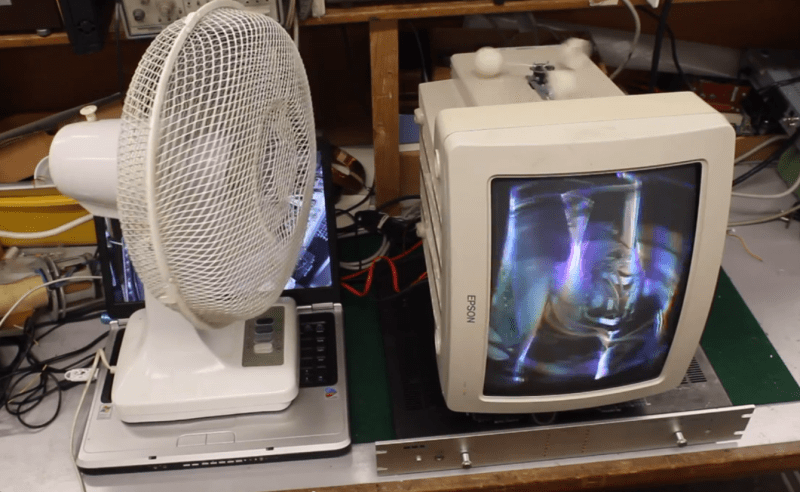From [Gijs] comes Beeldbuis Vlag Tijsdlijn, or television tube flag (Translated). We’re not up on our Dutch, but it appears that [Gijs] and friends have created a television tube which waves much like a flag in response to airflow from a fan. The effect is pretty darn amazing, and that’s putting it mildly. To create this hack, [Gijs] built a modified Wobbulator. The Wobbulator is an early video synthesizer which used added steering coils to modify the operation of a standard TV tube. When excited, the coils would deflect the tube’s electron beam, causing some rather trippy images to appear on-screen. (Yes, here at Hackaday “trippy” is a scientific term).
[Gijs] wanted his screen to be “waved” by a fan, just like a flag would wave. To do this he used an anemometer made of ping-pong ball halves. The anemometer spins up a DC motor from a CD-ROM drive. In this application, the motor acts as a generator, creating a DC voltage. An ATmega328 running the Arduino code reads the voltage from the motor. If the anemometer is spinning, the Arduino then outputs a sinusoidal value. The Arduino’s output is amplified and applied to the coil on the CRT. A network of power resistors ensures the amplifier is correctly loaded. The results speak for themselves. In the video after the break, the tube flag is displaying a slide show of photographs of its construction. As an added hack, [Gijs] used an Arduino Leonardo as a USB keyboard. When the anemometer spins, the primary ATmega328 sends a signal to the Leonardo, which then emulates a push of the arrow keys on the host computer. This lets the tube flag advance its own images. Very cool work indeed!
















Tijsdlijn is a typo of the word “tijdlijn” which means timeline.
I guess they have placed a magnet coupled to the anenometer. when this one rotate the magnet come near the CRT tube neck creating distortion in deflection coils magnetic field.
Better idea a bicycle dynamo which output is connected to a winding around the neck of CRT tube.
Checked their web site . This is not a dynamo but a small DC motor extracted from a VCR or something alike. Same result.
I don’t think the motor alone would have enough power to move the electron beam. The motor’s output is monitored by an Arduino, which in turn drives the coil based on sine tables.
If only there was a way to “amplify” the signal, if you will. Some sort of device that could take a small signal as an input and produce an identical and yet more powerful copy of it as an output. I shall commence work on it immediately, and when I am finished the world shall marvel at my new invention. I shall call it the “amplificator”.
Andrew – check out the silver box in the bottom of the article picture. You will find your amplification nirvana there ;-) Seriously though – simply sending an amplified version of the generator output wouldn’t produce the “flag waving” effect [Gijs] was looking for. He probably could have done it with an LFO, but he went the Arduino route.
Put that fan motor close enough to the yoke and it’ll do the same thing.
Any magnetic field in fact. Take a speaker magnet and place it on the tube face and see what append. A CRT tube is an electron gun shooting 3 electron beams to the phosphor dots on the face plate. Electrons are deflected by any magnetic field.
Well I know a fan works because I had a bad monitor once that shut down when it overheated. So I put a fan next to it to cool it down. When the fan was too close it’d make the screen ah how should I put it? Go all kinds of crazy is the best way I can describe it.
Was I the only one to think (from seeing the picture) the fan was to keep the monitor from overheating when run on its side?
http://hackaday.com/2006/11/09/analog-video-synth/
Blast from the 8 year ago past.
“(Yes, here at Hackaday “trippy” is a scientific term).”
I can assure you that this is also the case in the Netherlands…
I made something very similar to this, the demo video I made is frankly quite poor, but you can see the flag effect at about the 4.00 minute mark:
http://vimeo.com/24636740
I had a student job with an office in a disused closet. Every time I heard a strange noise coming from the wall, my 3270 terminal would wave around. It was the elevator on the other side of the wall.
Love this guy’s site. He lives quite close to me, I really should go visit sometime..
The real question is: why is the fan sitting on top of a laptop?